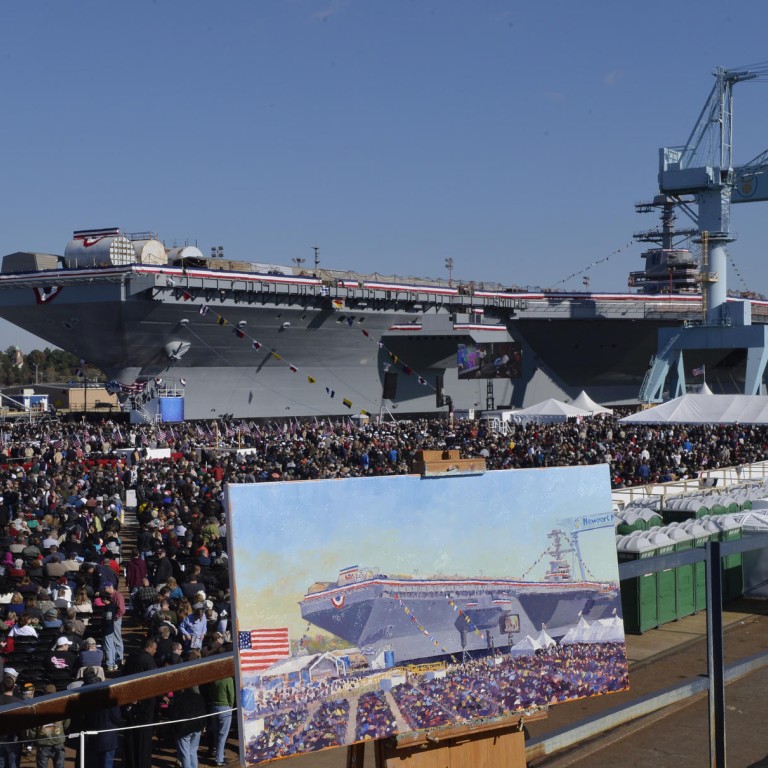
Navy christens carrier USS Gerald R. Ford, said to be 'technology marvel'
Aircraft carrier USS Gerald R. Ford, with its array of electronic wizardry, christened, but costs could delay its entry to service
The United States navy has christened the first of its next generation of aircraft carriers, a multibillion-dollar vessel hailed as the most technologically advanced warship ever built.
The USS Gerald R. Ford, which has been plagued by huge cost overruns at a time of growing budget pressures, is due to begin service in 2016.
The US$13 billion nuclear-powered carrier, which is equipped with an array of technological wizardry, was christened with a bottle of champagne at a ceremony in Newport News, in the state of Virginia, near the sprawling Norfolk naval base.

The Ford represents the first new design for a carrier in 40 years, and the navy's chief of staff, Admiral Jonathan Greenert, called the ship "a technological marvel".
All the festivities belied problems with the ship, however, which is only 70 per cent complete, with delivery postponed until February 2016.
Moreover, faced with automatic budget cuts and the need to fund other programmes, including submarines, Greenert has warned the service may have to delay completing the Ford "by two years".
The move would force the United States to rely on a fleet of 10 existing carriers and means "lowering surge capacity" in a crisis, he added.
US law requires that the military to maintain 11 aircraft carriers, but at the moment only 10 are available since the retirement of the USS Enterprise last year.
Video: US Navy christens costly new aircraft carrier USS Ford
The current carrier fleet, launched between 1975 and 2009, are Nimitz-class nuclear-powered ships, but the Ford, or CVN 78, represents a new class of carrier with a new design, which will be followed by the John F. Kennedy and new Enterprise carriers. All have a similar length of about 330 metres.
The Ford-class design is supposed to allow for 25 per cent more sorties for the fighter jets and helicopters on board, generate more electrical power and produce more fresh water from desalination systems, which would allow sailors to take comfortable showers.
"The Ford class is designed to provide increased war-fighting capability with approximately 700 fewer crew members," which would reduce the cost of maintaining the ship, the navy said in a statement.
While fewer sailors will be needed to run the carrier, the cost of building the ship has sky-rocketed. Since the start of the contract in 2008, construction costs have risen 22 per cent over the scheduled budget to US$12.8 billion in total.
The navy's estimate "does not include [US]$4.7 billion in research and development costs", according to the Congressional Budget Office, which provides financial data to lawmakers.
Navy officers say such cost overruns are typical for a new series of ship and that the price of subsequent vessels in the class tends to drop. But at a time of budget austerity, the growing price tag is a source of irritation.
The navy and the defence contractor "must still overcome significant technology development, design and construction challenges", the Government Accountability Office (GAO), which is an investigative arm of Congress, wrote in September.
The GAO questioned the decision to go ahead with new technological systems for the ship before proving they worked, an approach that "introduces risk of late and costly design changes and rework".
A new electromagnetic catapult to launch aircraft, new radar and new arresting gear to catch planes landing are also facing technical delays and higher costs.
"But even after the ship's commission, several key ship systems will continue to face significant reliability shortfalls that will likely increase costs to the government and limit the ship's mission effectiveness," the GAO said.
BY THE NUMBERS
Length: 337 metres
Width of flight deck: 78 metres
Height: 76 metres
Size of its four propellers: 6.4 metres in diameter, 30 tonnes each
Weight: More than 90,000 tonnes
Aircraft on board: 75
Crew: 4,660 sailors
Meals produced each day: 15,000
Cost: US$12.9 billion
What was needed to build the aircraft carrier:
● 4,500-tonne crane (it can lift the weight of about 150 empty school buses)
● 44,000 high-efficiency fluorescent light bulbs (enough to light up more than 1,000 houses)
● 757,082 litres of paint (enough to cover the White House 350 times)
● 219,200 metres of fibre-optic cable (enough to reach the international space station three times)
The Washington Post
